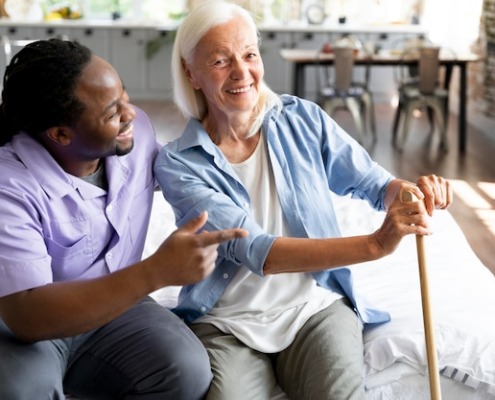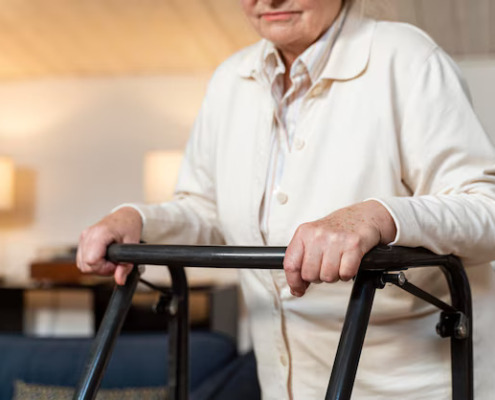Creating Safe and Accessible Spaces for Senior Living
 Creating safe and accessible spaces in senior living homes is more important than ever. With a rising number of seniors opting for independent and assisted living, thoughtful design can dramatically enhance their quality of life. From preventing accidents to boosting independence, every detail matters.
Creating safe and accessible spaces in senior living homes is more important than ever. With a rising number of seniors opting for independent and assisted living, thoughtful design can dramatically enhance their quality of life. From preventing accidents to boosting independence, every detail matters.
This guide explores the principles, features, and innovations that make senior living spaces safer and easier to use – and will help as you consider the move for yourself and a loved one to a senior living community.
Jump to article sections:
- Safety and Accessibility in Senior Living Homes
- Key Principles of Design for Senior Living
- Essential Safety Features for Senior Living Homes
- Designing Accessible Bathrooms and Kitchens for Seniors
- Technology and Smart Home Solutions for Senior Safety
- Modifications to Keep Seniors Safe at Home
- Key Considerations for Choosing a Senior Living Home
1. Safety and Accessibility in Senior Living Homes
Safety and accessibility are critical for creating a nurturing environment for seniors. According to studies, one in four adults aged 65 or older will experience a fall each year, often leading to serious injuries. By addressing common hazards through design, we can significantly reduce risks while empowering seniors to live more independently.
Additionally, accessibility isn’t just about mobility. It’s about creating an environment where seniors feel comfortable and confident in using every part of their home. This includes considering declining vision, reduced dexterity, and other age-related changes to ensure a space that works for everyone.
By investing in smart layouts and features, you provide a sense of security, confidence, and dignity for older adults transitioning to a new home.
2. Key Principles of Design for Senior Living
Design plays a significant role in creating spaces that work for seniors. This approach focuses on making environments usable for people of all ages and abilities, eliminating the need for costly future remodels. Here are some key principles:
- Flexibility in Use: Spaces should accommodate people with varying abilities. For example, adjustable-height countertops work equally well for someone seated in a wheelchair or standing.
- Equitable Use: Features like wide doorways and zero-step entrances ensure access for individuals with walkers, canes, or wheelchairs.
- Low Physical Effort: Lever-style door handles and faucets are much easier to use than traditional round designs, particularly for those with arthritis.
Applying these principles means designing spaces that don’t just “meet needs” but actively enhance daily life for seniors.
3. Essential Safety Features for Senior Living Homes
Safety begins with attention to detail. Here are some must-have features in any senior-friendly environment:
- Non-Slip Flooring: Choose flooring materials that reduce the chance of slipping, even when wet. Carpets with low pile and non-slip vinyl are excellent options.
- Grab Bars and Handrails: These should be strategically placed in bathrooms, hallways, and stairways to provide support where needed most.
- Emergency Call Systems: Install accessible call buttons or wearable alert devices to help seniors summon help in an emergency.
- Clear Walkways: Remove clutter and ensure furniture placement allows easy navigation.
By proactively addressing these details, you help create a home that minimizes hazards and maximizes peace of mind.
4. Designing Accessible Bathrooms and Kitchens for Seniors
Bathrooms and kitchens are two of the most used spaces in any home, and they can also be the most hazardous for seniors. Here’s how to make them safer and more accessible:
Accessible Bathrooms:
- Walk-In Showers: Replace traditional tubs with curbless showers to eliminate tripping hazards. Incorporate built-in seating for added safety.
- Grab Bars: Install grab bars near the toilet and inside the shower to help seniors maintain balance.
- Non-Slip Surfaces: Use non-slip tiles or mats to prevent falls.
Senior-Friendly Kitchens:
- Lower Cabinets: Opt for pull-out shelving and lower storage to reduce the need for stretching or crouching.
- Easy-to-Use Fixtures: Install lever-style faucets and easy-to-read appliance controls.
- Lighting: Ensure good task lighting over countertops and cooking areas.
These changes make daily activities not just safer but also more enjoyable.
5. Technology and Smart Home Solutions for Senior Safety
Advances in technology are reshaping senior living. Smart home solutions not only improve safety but also foster independence. Here are a few examples:
- Fall Detection Systems: Devices like smart watches can detect falls and alert caregivers immediately.
- Voice-Activated Devices: Small touches, like smart speakers, make it easy to control lights, thermostats, and even call for help.
- Monitoring Systems: Non-invasive sensors can track daily activities and notify caregivers of irregularities without compromising privacy.
These user-friendly technologies contribute significantly to both peace of mind and convenience.
6. Modifications to Keep Seniors Safe at Home
For seniors aging in place at home, practical modifications can make a significant difference in reducing risks and promoting independence. Installing grab bars in bathrooms, near toilets, and by bathtubs or showers can provide essential support and prevent falls. Enhancing lighting, especially in hallways, stairs, and other frequently used areas, helps improve visibility and minimizes the chance of accidents.
Removing tripping hazards, such as loose rugs or clutter, ensures clear pathways and safer navigation. Additionally, creating accessible spaces by widening doorways, lowering countertops, and using ramps instead of stairs accommodates mobility aids like walkers or wheelchairs.
7. Key Considerations for Choosing a Senior Living Home
 When assessing a senior living home, make safety and accessibility top priorities. Ensure there are features like grab bars in bathrooms, slip-resistant floors, and ample space to accommodate mobility devices such as wheelchairs or walkers. Designs that are easy to move through, well-lit corridors, and emergency call systems are critical for promoting safety and peace of mind.
When assessing a senior living home, make safety and accessibility top priorities. Ensure there are features like grab bars in bathrooms, slip-resistant floors, and ample space to accommodate mobility devices such as wheelchairs or walkers. Designs that are easy to move through, well-lit corridors, and emergency call systems are critical for promoting safety and peace of mind.
Additionally, consider whether the community promotes meaningful interactions through group activities and shared areas, helping residents remain active and socially connected. Verify that the staff delivers personalized, compassionate care, creating a welcoming and supportive atmosphere suited to each resident’s needs.
Don’t forget to ensure that the retirement home staff is trained on emergency procedures like medical emergencies and even natural disasters. You should also inquire about the facilities security systems to prevent things like break-ins and wandering residents.
For a senior living home in the Wauwatosa area that prioritizes safety and accessibility, consider Harwood Place. Our dedicated staff provides around-the-clock support for all residents, ensuring that they feel comfortable and secure in their new home. Call us today to schedule a tour of our Wauwatosa senior living home today!




 Dr. Champalal Gupta, MD
Dr. Champalal Gupta, MD


